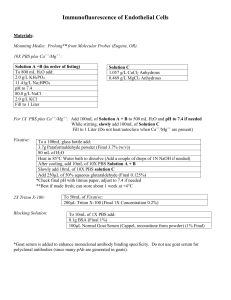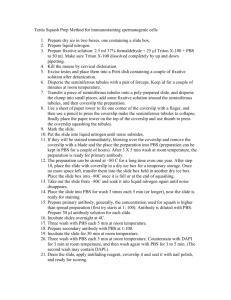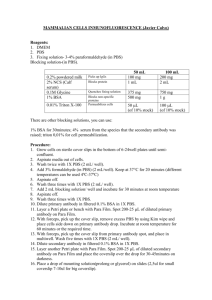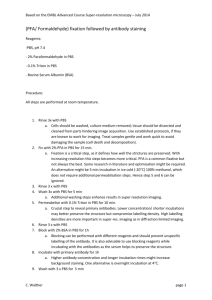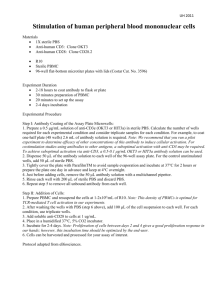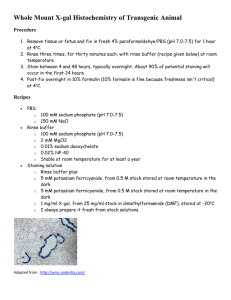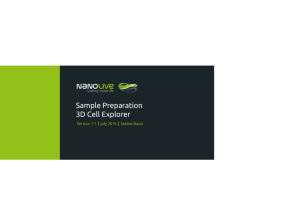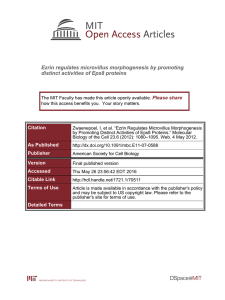Berryman Fluorescence Microscopy Lab 2006
advertisement
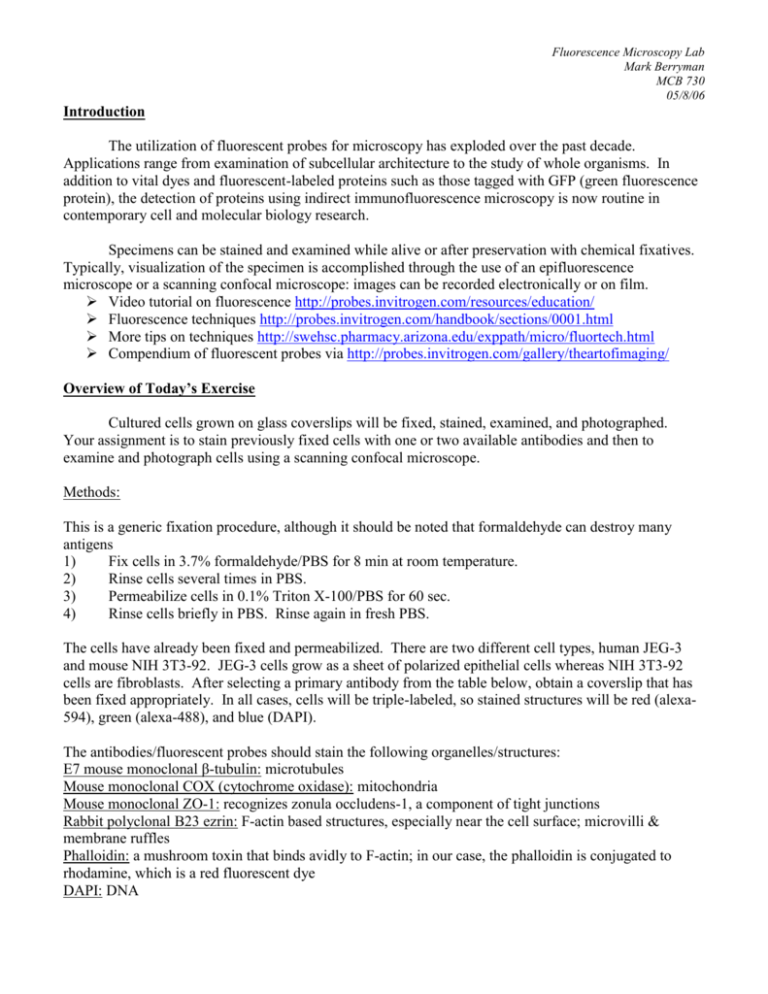
Fluorescence Microscopy Lab Mark Berryman MCB 730 05/8/06 Introduction The utilization of fluorescent probes for microscopy has exploded over the past decade. Applications range from examination of subcellular architecture to the study of whole organisms. In addition to vital dyes and fluorescent-labeled proteins such as those tagged with GFP (green fluorescence protein), the detection of proteins using indirect immunofluorescence microscopy is now routine in contemporary cell and molecular biology research. Specimens can be stained and examined while alive or after preservation with chemical fixatives. Typically, visualization of the specimen is accomplished through the use of an epifluorescence microscope or a scanning confocal microscope: images can be recorded electronically or on film. Video tutorial on fluorescence http://probes.invitrogen.com/resources/education/ Fluorescence techniques http://probes.invitrogen.com/handbook/sections/0001.html More tips on techniques http://swehsc.pharmacy.arizona.edu/exppath/micro/fluortech.html Compendium of fluorescent probes via http://probes.invitrogen.com/gallery/theartofimaging/ Overview of Today’s Exercise Cultured cells grown on glass coverslips will be fixed, stained, examined, and photographed. Your assignment is to stain previously fixed cells with one or two available antibodies and then to examine and photograph cells using a scanning confocal microscope. Methods: This is a generic fixation procedure, although it should be noted that formaldehyde can destroy many antigens 1) Fix cells in 3.7% formaldehyde/PBS for 8 min at room temperature. 2) Rinse cells several times in PBS. 3) Permeabilize cells in 0.1% Triton X-100/PBS for 60 sec. 4) Rinse cells briefly in PBS. Rinse again in fresh PBS. The cells have already been fixed and permeabilized. There are two different cell types, human JEG-3 and mouse NIH 3T3-92. JEG-3 cells grow as a sheet of polarized epithelial cells whereas NIH 3T3-92 cells are fibroblasts. After selecting a primary antibody from the table below, obtain a coverslip that has been fixed appropriately. In all cases, cells will be triple-labeled, so stained structures will be red (alexa594), green (alexa-488), and blue (DAPI). The antibodies/fluorescent probes should stain the following organelles/structures: E7 mouse monoclonal β-tubulin: microtubules Mouse monoclonal COX (cytochrome oxidase): mitochondria Mouse monoclonal ZO-1: recognizes zonula occludens-1, a component of tight junctions Rabbit polyclonal B23 ezrin: F-actin based structures, especially near the cell surface; microvilli & membrane ruffles Phalloidin: a mushroom toxin that binds avidly to F-actin; in our case, the phalloidin is conjugated to rhodamine, which is a red fluorescent dye DAPI: DNA Fluorescence Microscopy Lab Mark Berryman MCB 730 05/8/06 Primary Antibody B23 ezrin & COX mAb B23 ezrin & ZO-1 mAb B23 ezrin & tubulin mAb COX mAb Tubulin mAb Secondary Antibody GAR-Alexa 594 & GAM-Alexa 488 GAR-Alexa 594 & GAM-Alexa 488 GAR-Alexa 594 & GAM-Alexa 488 GAM-Alexa 488 & Rhodamine-phalloidin GAM-Alexa 488 & Rhodamine-phalloidin Cell type Human JEG-3 Human JEG-3 Human JEG-3 Mouse 3T3 Mouse 3T3 *Be sure you use the correct combination of primary and secondary antibodies for the appropriate cell type. All specimens, including the control (omit primary antibody) will be stained with DAPI to label DNA. 5) 6) 7) 8) 9) 10) 11) 12) Incubate cells in primary antibody (20μl) diluted in PBS for 30 min: place coverslip in humid chamber at room temperature. Rinse cells in PBS for 5 min: dip coverslips several times. Incubate cells in appropriate secondary antibody diluted in PBS for 30 min (0.05mM DAPI is included with the secondary antibody to allow visualization of DNA). Rinse cells in fresh PBS for 5 min. Mount coverslip on a clean glass slide: quickly drain excess PBS on a piece of filter paper, then gently place coverslip on a small amount (6.5μl) of commercial antifade mounting medium (ProLong Gold: Molecular Probes). Place slide in dark overnight at room temperature to allow mounting medium to cure. Carefully seal edge of coverslip with clear nail polish. Allow polish to dry. Rinse the surface of the coverslip with water to remove salt. Blot dry with edge of kimwipe—do not touch coverslip. Store slide at -20°C. General Notes: (a) The concentration of fixative and duration of fixation should be optimized empirically for each antigen and antibody studied. (b) Cells can also be fixed and simultaneously permeabilized using organic solvents such as absolute ethanol or acetone and then rehydrated in PBS. Note that methanol fixation precludes visualization of the actin cytoskeleton with fluorescent-labeled phalloidin. Various methods of permeabilization should be compared to test for retention of antigenicity and possible alterations in antigen distribution that may result from extraction of cellular membranes. (c) Background staining may be minimized by the inclusion of a suitable blocking protein (e.g. 1-5% normal goat serum) or a low concentration of detergent (e.g. 0.05% Tween 20) during antibody incubations. (d) Never allow cells to dry during staining or mounting. Also, be careful not to move or touch the coverslip when applying nail polish. Fluorescence Microscopy Lab Mark Berryman MCB 730 05/8/06 Assignment 1. After the laboratory exercise on confocal microscopy, a TA will assist you in taking photos of your specimen. Please bring a blank CD or other electronic storage medium to the confocal microscope laboratory. 2. Assemble your best photographs into a single color figure as if it were being submitted for publication. Individual panels should be clearly labeled. Include a scale bar. Provide an accompanying figure legend (one paragraph) that concisely describes the specimen (i.e. cell type), method of fixation, and the reagents used for staining. Briefly describe the subcellular distribution of the proteins you stained in terms of their known functions. Incorporate sufficient background information about the proteins being localized and the pattern of stained structures so that a naïve reader can understand your description of the salient features of the figure (e.g. stage of cell cycle, subcellular distribution of protein, structures with prominent staining, spatial-temporal relationship between stained structures, etc…). Although you did not perform a parallel control in this exercise, briefly describe at least one type of control you would normally do to account for non-specific background staining. 3. Please submit your assignment by email (berryman@ohiou.edu) no later than May 25. Score will be reduced by one letter grade for each day past the deadline.

